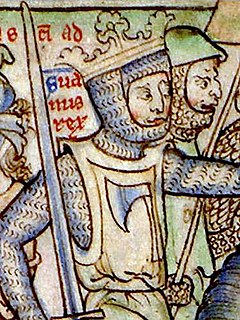
Æthelred, known as the Unready, was King of the English from 978 to 1013 and again from 1014 until his death in 1016. His epithet does not derive from the modern word "unready", but rather from the Old English unræd meaning "poorly advised"; it is a pun on his name, which means "well advised".

Sweyn Forkbeard was king of Denmark from 986 to 1014. He was the father of King Harald II of Denmark, King Cnut the Great and Queen Estrid Svendsdatter.

Cnut the Great, also known as Canute, was King of England, Denmark and Norway, often referred to together as the North Sea Empire during his rule.

The Danelaw was the part of England in which the laws of the Danes held sway and dominated those of the Anglo-Saxons. The Danelaw contrasts with the West Saxon law and the Mercian law. The term is first recorded in the early 11th century as Dena lage. The areas that constituted the Danelaw lie in northern and eastern England, long occupied by Danes and other Norsemen.
Ælfgifu of Northampton was the first wife of Cnut the Great, King of England and Denmark, and mother of Harold Harefoot, King of England. She was regent of Norway from 1030 to 1035.

Thorkell the Tall, also known as Thorkell the High in the Anglo-Saxon Chronicle, was a prominent member of the Jomsviking order and a notable lord. He was a son of the Scanian chieftain Strut-Harald, and a brother of Jarl Sigvaldi, Hemingr and Tófa. Thorkell was the chief commander of the Jomsvikings and the legendary stronghold Jomsborg, on the Island of Wollin. He is also credited as having received the young Cnut the Great into his care and taken Cnut on raids. The Encomium Emmae, a document aimed at the movers and shakers of the Anglo-Scandinavian court in the early 1040s, describes Thorkell as a great war leader and warrior.

Eadric Streona was Ealdorman of Mercia from 1007 until he was killed by King Cnut. Eadric was given the epithet "Streona" in Hemming's Cartulary because he appropriated church land and funds for himself. Eadric became infamous in the Middle Ages because of his traitorous actions during the Danish re-conquest of England.

The Battle of Assandun was fought between Danish and English armies on 18 October 1016. There is disagreement whether Assandun may be Ashdon near Saffron Walden in north Essex, England, or, as long supposed, Ashingdon near Rochford in south-east Essex. It ended in victory for the Danes, led by Canute the Great, who triumphed over the English army led by King Edmund Ironside. The battle was the conclusion to the Danish conquest of England.
Ælfric was Ealdorman of Hampshire from c. 982 to 1016.
The Thingmen was a standing army in the service of the Kings of England during the period 1013-51, financed by direct taxation which had its origins in the tribute known as Danegeld. It consisted mostly of men of Scandinavian descent and it had an initial strength of 3,000 housecarls and a fleet of 40 ships, which was subsequently reduced. Its last remnant was disbanded by Edward the Confessor in 1051.
Events from the 1010s in England.
Events from the 10th century in the Kingdom of England.
The Battle of Ringmere was fought on 5 May 1010. Norse sagas recorded a battle at Hringmaraheiðr; Old English Hringmere-hūō, modern name Ringmere Heath.
Ælfgifu of York was the first wife of Æthelred the Unready, by whom she bore many offspring, including Edmund Ironside. It is most probable that she was a daughter of Thored, Earl of southern Northumbria.
Thored was a 10th-century ealdorman of York, ruler of the southern half of the old Kingdom of Northumbria on behalf of the king of England. He was the son of either Gunnar or Oslac, northern ealdormen. If he was the former, he may have attained adulthood by the 960s, when a man of his name raided Westmorland. Other potential appearances in the records are likewise uncertain until 979, the point from which Thored's period as ealdorman can be accurately dated.

North Sea Empire and Anglo-Scandinavian Empire are terms used by historians to refer to the personal union of the kingdoms of England, Denmark and Norway for most of the period between 1013 and 1042 towards the end of the Viking Age. This ephemeral Norse-ruled empire was a thalassocracy, its components only connected by and dependent upon the sea.
The Battle of the Holme took place in East Anglia on 13 December 902 where the Anglo-Saxon men of Wessex and Kent fought against the Danelaw and East Anglian Danes. Its location is unknown but may have been Holme in Huntingdonshire.

Viking activity in the British Isles occurred during the Early Middle Ages, the 8th to the 11th centuries, when Norsemen from Scandinavia travelled to Great Britain and Ireland to settle, trade or raid. Those who came to the British Isles have been generally referred to as Vikings, but some scholars debate whether the term Viking represented all Norse settlers or just those who raided.
The Battle of Buttington was fought in 893 between a Viking army and an alliance of Anglo-Saxons and Welsh.
The battle of Thetford occurred in 1004. Sigvat records the victory of King Ethelred, allied with Saint Olaf, over the Danes under Sweyn Forkbeard during the latter's campaigns in England.







